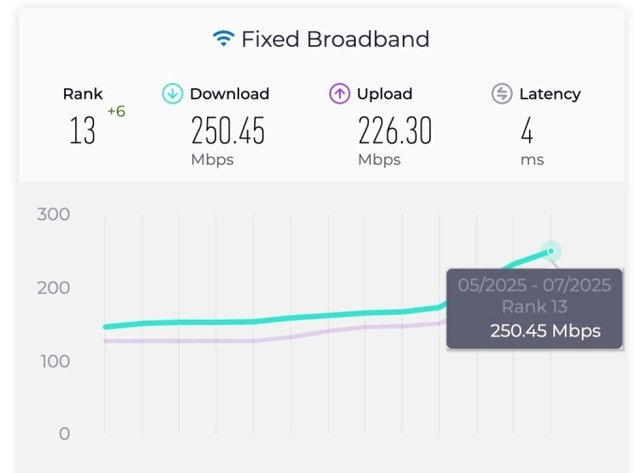Viet Nam makes big leap forward after 30 years of global Internet connectivity
VGP - Over the past three decades, Viet Nam has transformed from a latecomer in global Internet connectivity into a fast-rising digital powerhouse, mastering core technologies in 5G systems, network equipment, and next-generation Internet solutions.

Viet Nam’s fixed broadband internet speed, powered largely by fiber-optic connections, rose to 13th place globally in July, its highest ranking ever.
From a nation that once ranked near the bottom of global Internet speed charts, Viet Nam has made giant strides in building robust digital infrastructure, advancing domestic technology, and expanding high-speed connectivity to millions.
As the country celebrates 30 years of integration into the global Internet, its journey reflects not only how far it has come but also how ready it is to stand among the foremost pioneers of the digital era.
From slow start to global recognition
Ten years ago, Viet Nam was still lagging behind. In the fourth quarter of 2015, Akamai Technologies reported the country's average Internet speed at just 3.8 Mbps, ranking 95th out of more than 100 markets worldwide.
In mid-August 2025, Ookla—the company behind the Speedtest tool—announced its Speedtest Awards for the best-performing carriers in the first half of the year. Viet Nam stood out with two telecom carriers recognized among the world's fastest.
Not only mobile networks but also fixed Internet services have surged. After months of strong performance, Viet Nam climbed to 10th place globally in the Speedtest Global Index—the highest position since the ranking was launched in 2017. This also represents the highest median Internet speed since Viet Nam first joined the global Internet in 1997.
Recently, Viet Nam’s fixed broadband internet speed, powered largely by fiber-optic connections, rose to 13th place globally in July, its highest ranking ever.
According to Ookla, the company behind Speedtest, Vietnam has recorded one of the strongest growth trends globally, with both speed and ranking rising month after month.
Breakthroughs in 5G and Wi-Fi 7
April 2024 marked a milestone when Viet Nam successfully held its first auction of 5G. Just six months later, the first commercial fifth-generation mobile network was launched. This not only demonstrated a major leap in mobile technology but also signified the official deployment of Vietnamese-made 5G equipment on domestic networks.
Innovation extended further in October 2024, when VNPT Technology introduced the first "Made-in-Vietnam" Wi-Fi 7 device with a speed of 10 Gbps. "This is the first Wi-Fi device in the Asia-Pacific region using XGSPON technology, and we are also among the first carriers to manufacture and bring such devices to market," a VNPT representative said at the launch event, which was attended by ST Liew, Vice President of Qualcomm Technologies.
By August 2025, FPT rolled out service packages supporting Wi-Fi 7 with XGS-PON technology, enabling users to experience speeds of 10 Gbps for both uploads and downloads.

Toward universal high-speed Internet
To sustain momentum, Viet Nam is pursuing ambitious goals for digital infrastructure. Resolution 57 of the Politburo sets a vision that by 2030 the country will achieve advanced, modern infrastructure with ultra-large capacity and ultra-broad bandwidth, on par with developed economies.
The Ministry of Science and Technology targets the deployment of 15 international submarine cable systems with a combined design capacity of 350 Tbps by 2030, including two under Vietnamese ownership, alongside two international terrestrial fiber-optic cables. By then, 100 percent of users are expected to have access to speeds of 1 Gbps.
Minister of Science and Technology Nguyen Manh Hung emphasized that telecommunications infrastructure is a "national strategic infrastructure," as vital as transportation and electricity. He has called for Viet Nam to aim for a "top 5, top 10" global position.
According to the Authority of Telecommunications, in the first half of 2025, Viet Nam's fixed broadband subscription rate reached 24.4 per 100 inhabitants, up 3.9 percent year-on-year. Household fiber-optic usage climbed to 85.3 percent, well above the global average of 60 percent.
This year also marks Viet Nam's mastery of the VSTN terrestrial fiber-optic cable system, with a designed capacity of 4 Tbps, expandable to 12 Tbps. This provides the backbone for high-speed connectivity and widespread 5G deployment.
Viettel Telecom, one of the country's leading carriers, has set an ambitious target of covering 91 percent of the population with 5G and attracting 12 million subscribers in 2025. To achieve this, the operator plans to deploy an additional 22,000 5G stations, bringing the total to 29,000.
If successful, Viettel's rollout will exceed four times the number of stations it launched in October 2024, and more than double the total 5G stations currently operated by all other carriers in the country combined (around 11,000)./.
